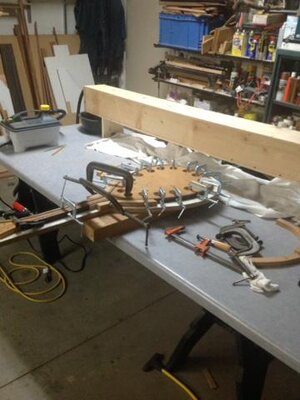Has anyone in the group used steam for bending planks for the hull? Is there a better way? And another quick question - has anyone built a jig to hold the bulkheads square to the keel during initial glue-up? I see the Fair-A-Frame offering but it looks flimsy. I can build one better but was wondering if anyone already did this and has a plan or design they might want to share? This is my first build (Artesiania Latina San Francisco II galleon) and I am looking forward to getting underway. Thanks for all your advice and help!
-

Win a Free Custom Engraved Brass Coin!!!
As a way to introduce our brass coins to the community, we will raffle off a free coin during the month of August. Follow link ABOVE for instructions for entering.
You are using an out of date browser. It may not display this or other websites correctly.
You should upgrade or use an alternative browser.
You should upgrade or use an alternative browser.
If you are working with planks 1/16" or less, letting them soak then clamping them to to the hull to dry or to a curved pice of scrap wood cut to the shape of the bow area is usually suffcient to get the curve you need.
Polydoc is quite correct - let them soak, or even better boil them in a pan. I prefer to bend the planks off the ship, using a template a bit tighter than the bend you want, as there will be a bit of 'spring-back'. Leave to dry overnight.
The soaking/boiling may raise the grain of the wood slightly, depending on species, but you will be sanding the hull later, so not a problem.
Hope this helps
Ted
The soaking/boiling may raise the grain of the wood slightly, depending on species, but you will be sanding the hull later, so not a problem.
Hope this helps
Ted
Happy new year to all, i am new to this site been on less than a month. On the other side of ship building over the last 40 years have experimented with various methods from steam to soaking in hot water, to a candle,,the best for me and the wood, is build yourself a little trough ,lots of ways to do so, big enough for lets say 6 to 10 pieces of the wood ,( planks) you wish to soak , i have a few ,various lengths from wood i glued then a few layers of clear varathane for a seal,and plastic containers like hachsaw blade containers,you get the idea,then fill that trough with 70 % rubbing alchohol, from a pharmacy. For 2 to 2 1/2 hours. Bend it around a curved wood jig or set up a plank of wood and use screws and hold that form less than a minute, you will find that the alchohol helps bend and hold, the shape as well evaporates and the wood is in a lot better condition than with soaking in water for a lot of reasons
The main reason I asked is because I already have a steam box and generator - I use them to build fly fishing hand nets. I can build a small form for clamping plates to shape but was wondering if its too much trouble (other than soaking). Each plank will have its own individual shape. Correct? Do you just use the bulkhead as a form with clamping?Polydoc is quite correct - let them soak, or even better boil them in a pan. I prefer to bend the planks off the ship, using a template a bit tighter than the bend you want, as there will be a bit of 'spring-back'. Leave to dry overnight.
The soaking/boiling may raise the grain of the wood slightly, depending on species, but you will be sanding the hull later, so not a problem.
Hope this helps
Ted
Attachments
Well ,my experience if you steam or soak the wood ,yes they will have there own shape , this is why i use alcohol i give it the shape i want and more than 90% of the time it is achieved by hand ,repeat the process, in a couple of minutes voila! All i can say without a video is experiment and you will see it's not that hard, maybe you will discover a better way. Let me know.
I looked at a picture of your model and the only place you have to deal with sharp bends is at the bow below the deck. Use the shape of the deck view at the bow in the plans to make your former (template). Gently bend the softened wood around it and clamp in place until dry. Curvature decreases as you approach the keel so you might need a second former later on. You just have to approximate the curve since wood is flexible. The model should have a filler at the bow for attaching the plank ends. If you use CN glue here and press the planks to the filler you should get good results.
Thank you!I looked at a picture of your model and the only place you have to deal with sharp bends is at the bow below the deck. Use the shape of the deck view at the bow in the plans to make your former (template). Gently bend the softened wood around it and clamp in place until dry. Curvature decreases as you approach the keel so you might need a second former later on. You just have to approximate the curve since wood is flexible. The model should have a filler at the bow for attaching the plank ends. If you use CN glue here and press the planks to the filler you should get good results.





